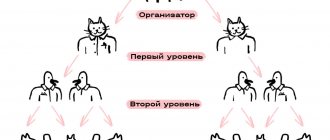4.4
(4501)
The success of a project management system depends decisively on the management organization. Even the most advanced information system will not work if the project manager does not have the necessary authority and support, and the decision-making system does not ensure the efficiency of control actions. And here PMI standards come to the rescue, allowing you to streamline and formalize project activities.
In this article, we will briefly consider various approaches to organizing project management in an enterprise, the advantages, disadvantages and areas of applicability of various organizational structures from the point of view of organizing project management. The information in this article is primarily based on the Project Management Institute's A Guide to the PMBOK. But first, a few definitions.
- The Coordination Council
is a collective body (often the board) that approves the selection of projects, work plans and their changes, appoints a curator and approves a project manager. - The project supervisor
is a management representative (usually a member of the coordinating council) who supervises the work on the project. - A project manager
is an individual responsible for managing a project. - The project team
is the people who report directly or indirectly on the project. - Project management team
- project team members directly involved in project management processes.
Functional structure
In our country, the most common functional structures for enterprise management are those in which each employee has one immediate supervisor, and the personnel are grouped according to their specialization (marketing, capital construction, planning, financial, etc. departments).
Such structures are well suited for managing established production, but make it difficult to manage complex projects that require direct operational interaction between specialists from different functional departments. In functional structures, assignments to project team members are issued only through the heads of the relevant departments, who coordinate the work of their employees (Fig. 1, personnel involved in the project are highlighted in green).
Fig. 1 - Functional management structure.
If the projects carried out in the organization are routine in nature (for example, scheduled equipment repairs), regularly repeated and well studied, the functional structure copes with them quite successfully. She also successfully copes with any projects that are limited to one functional department.
If projects affect several departments and have no analogues in the history of the organization, then the implementation of such projects within the framework of the functional structure faces serious difficulties. These difficulties are caused by problems with coordination of work, and by the fact that the interests of functional managers are not limited to the interests of the project and may even conflict with them.
4K technology
The cutting-edge ULTRA HD 4K technology used by monitors and projectors differs from the well-known HD and Full HD formats in the number of pixels in the image, as well as their size.
This technology is rapidly gaining popularity. It is known that the higher the quality of a picture, the more pixels it contains and the smaller their size.
Thanks to this, it will be possible to consider many more small elements. If the image has a lower resolution, 4K TVs, even with 32-inch diagonals, will show it better than HD and Full HD.
This is explained by the fact that on screens with such technologies the number of pixels in the image is greater. It is important to understand that the image needs to be enlarged the more, the smaller the elements in its composition.
This is the only way to consider it in as much detail as possible. This explains the fact that when switching to the 4K format, it is better to give preference to TV models that have a larger screen.
4K technology is the highest quality, as well as a fourfold increase in the volume of elements when compared with Full HD technology.
Project structure
The direct opposite of functional is project structure.
management, in which each member of the project team also has one immediate supervisor, but the divisions are organized according to the project principle: project management teams form their own divisions (Fig. 2), headed by managers of the corresponding projects. Such structures are typically used by project-oriented organizations that carry out projects for others, such as consulting companies.
Fig. 2 - Project management structure.
Employees of functional departments included in the project team temporarily leave their departments and become subordinate to the project manager for the period of its implementation. An extreme case is the creation of a special company to manage a single project (management company), the life of which coincides with the implementation period of the project. Typically, such companies are created for very large projects (examples: Starstroy - management of the construction of the Caspian pipeline; Desam - management of the construction of the Oncology Center in Samara).
In a project structure, the project manager has full authority. Project team members leave their functional departments and report to project managers in project-oriented units. This ensures complete coordination of the work of the project team. However, this structure also has serious disadvantages.
- Not all project team members are 100% busy with project work. At the same time, their responsibilities in functional units fall on the shoulders of others, additional personnel have to be recruited, and as a result, the organization's resources are not used effectively.
- After the completion of the project, problems arise with the employment of personnel in project departments: their places in functional departments may be filled.
- Specialists are pulled out of their professional environment, which hinders their professional growth.
- Project structures are best suited for managing projects that are unique to the organization, complex, high-profile, or large-budget.
The theory or frequency varies.
Do not confuse the refresh rate of the LCD matrix with the frame rate of the video.
Frame refresh rate is the number of frames of video content displayed on the TV screen in 1 second. The frequency depends on the type of content.
The standard filming rate is 24 frames per second. The frequency of TV content is 50 frames per second (in European countries).
The screen refresh rate is a parameter that shows how many frames per second the LCD panel of the TV can display; this value does not affect the image quality in movies.
Where can a higher refresh rate of the LCD matrix be used?
For example, when connected to a computer, a TV with a 120 Hz LCD matrix will display smoother animations of windows and desktops in Windows.
With an appropriate video card, you can get good images in games.
Do a little test. Set your monitor settings to a lower refresh rate (for example, 30Hz in four-line scanning) and see how the display changes in the operating system itself. Then run any video in this mode.
The result will be the following - the low frequency of the monitor will not affect the quality of the video image, only the display of the desktop in the system.
Why all this reasoning? The fact is that the high frequency of the LCD matrix on the TV does not affect the quality of the display of films (except 3D).
Why do we need additional personnel?
In CRT TVs with a screen diagonal of more than 70 cm, at a standard frequency of 50-60 Hz, significant flickering was observed and additional strain on the eyes occurred. The reason for this was not the number of personnel, but the peculiarity of the technology itself. Therefore, engineers created a CRT TV with a refresh rate of 100Hz. At this frequency, the picture did not blink and did not tire our eyes. It is because of this that the misconception has arisen that a TV with a high refresh rate does not affect vision.
In an LCD TV with a frequency of 60Hz, flickering is not observed, and increasing the refresh rate is necessary for completely different purposes.
Technology 100,200,400,800Hz…
If not frequency, then what affects image quality in films, you ask?
The main disadvantage of LCD TVs is the reduction in resolution of the displayed frame when moving.
This is affected by the response of the matrix, caused by the liquid crystals slowly switching from the current color to absolute black and back again. Any plasma TV will be an example of high-quality recreation of fast scenes in films. The clarity of the image in motion is called dynamic resolution, it is this parameter that greatly affects the quality of the image. To achieve the standard display of dynamic scenes in films, manufacturers resort to various methods.
1.Use of LED backlight to increase the dynamic resolution of content - scanning backlight.
The simplest method. There is an effect on the clarity of the picture, but at the same time the brightness decreases and strong flickering is observed. The benefit of this function is very doubtful. Used in budget models.
2.Insertion of additional frames. The technology requires a powerful processor and is used in mid-price models.
The impact on dynamic resolution is significant. It has a number of disadvantages: - if this function is turned on when watching regular films, a performance effect will appear:
— when creating additional frames, significant artifacts may be observed in the form of incorrect frame overlay and afterimages.
3. Combined method. The above technologies, plus various algorithms for processing, smoothing and eliminating image defects.
The best decision. You can adjust the creation of additional frames and the degree of suppression of the motion blur effect separately. Thus, achieving high dynamic resolution in films (24fps) without the effect of a performance.
The numerical value indicated by manufacturers is the image processing index, the sum of which includes the work of all components of the TV. The effectiveness of the index does not depend on the numerical value.
Matrix structures
Lately, matrix project management structures have become increasingly popular. In such structures, project team members do not leave their functional units, but report directly to the project manager for project work. At the same time, the functional manager is not relieved of responsibility for the quality of work of his employees and the compliance of manufactured products with accepted standards and rules.
Matrix management structures are typically used when projects are repetitive but not routine.
Fig. 3 - Influence of project characteristics on the choice of optimal organizational structure
Depending on the authority of the manager, projects distinguish between weak
and
strong matrix
.
In a weak matrix, project team members are managed not directly, but through functional managers. The powers of the project manager in such a structure are limited, so this position is called differently. At the same time, forms of management are distinguished, which are called project forwarder
and
project coordinator
, based on the name of the functions of those people who are tasked with managing the project.
Importance of image processing systems.
If we talk about the parameters of image processing systems described at the beginning of the article, then you need to understand the following, they are all created to improve image perception, although they have different names and sizes.
Manufacturers essentially use this parameter for marketing purposes. For example, since June 2015, LG introduced a new name PMI (Picture Mastering Index) - an image enhancement index, the maximum value of which can reach 2000 PMI. But the fact is that no one yet knows how this index is calculated and this transition to a new index with a higher numerical value is most likely caused by the desire to sell more TVs, since the buyer will certainly pay attention to the model with a higher index.
Whatever the technical significance of the TV, a simple method will help you choose the best TV.
We upload video with dynamic scenes of Full HD 1920*1080 quality (video with fast movement of objects), for example, a highway with a fast passing car or fight scenes where actors perform sudden movements, to a flash drive. Next, we go to the store and ask the manager to turn on the video from the flash drive on the TV we like. In this way, you can compare the image quality of TVs with different Hertz indicators and image processing systems without paying attention to the numbers.
If you have two TVs of the same size with frequencies of 100 Hz, but different values of image processing systems, and they show dynamic scenes equally well, then choose the one that is cheaper - why pay for large numbers that essentially do not affect anything.
Source: azzaron.ru
Project forwarder
Project forwarder
is an employee of one of the functional departments who is tasked with coordinating the flow of information between members of the project team (Fig. 4). He has no powers other than the right to make recommendations. Such a system only works if the forwarder has sufficient influence (often informal), and is only applicable for not very important, small and short projects.
Fig. 4 - Project forwarder
What is HDR
Unique High Dynamic Range (HDR) technology represents the latest video standards developed specifically for the latest models. This is a video format in which each pixel has ultra-high resolution, more information about brightness and color. But not all TVs have the ability to support this technology; it requires plasma screens and specially filmed and processed video.
The technology ensures a more vibrant and realistic picture is transmitted to the screen. In addition, there will no longer be restrictions, as there were in older TV models.
The main advantages of the technology include the following:
- the richest color palette;
- wider range of brightness.
It is a mistake to consider HDR technology on TV and the photo effect to be similar, where one photo with an imitation of an extended range is created by combining several photos.
As for the TV, the video is shot in HDR format initially. This provides a picture that looks as vibrant and realistic as possible.
Project coordinator
Project coordinator
reports directly to the management of the enterprise and is often the project supervisor. He has the right to assign tasks to employees of functional departments, although he is not vested with official powers. Typically, the project coordinator has a high status in the functional organization (deputy director, chief specialist). In our design institutes there is an institute of GIPs, who are actually project coordinators.
In this structure, the likelihood of conflicts is especially high due to the double subordination of employees and the lack of clearly defined powers of managers. Typically, such conflicts are resolved by the management of the enterprise.
Weak matrix structures (forwarder and project coordinator) are usually used when an organization carries out many small, but not routine projects (example: the work of design institutes that carry out tens and hundreds of small projects annually).
Fig.5 - Project coordinator
What is LED TV technology
The manufacturing technology of the device screen determines the level of quality when transmitting images.
Today there are two types of panels:
- Liquid crystal matrices with light emitting diodes (LEDs). The advantages of LED TVs are that the use of ice production provides excellent color rendition, contrast and image clarity, and a wide viewing angle.
- Matrices with organic LED screen (OLED). This category is more advanced. Here, a separate pixel is an LED that can glow on its own, thereby ensuring the most accurate light transmission and contrast.
Oled TV technology is capable of transmitting up to a million color shades, which is 64 times more than Edge LED technology. As for black depth, it is ensured by turning off some pixels on screens that are not used.
This technology has a much larger viewing angle, wider, and if we talk about the thickness of the panels, then it is much thinner. If we talk about the image update speed of OLED displays, then it is many times higher, which ensures high accuracy of images that move.
Strong matrix
In a strong matrix structure, there is the position of a project manager, who has the authority to directly give orders and demand accountability from employees of functional units that are part of the project management team. Project managers in such a structure are not included in functional departments, except for the project office (project management department, project management service, analytical center - names may vary). Members of the project management team are not removed from their functional units, but are “seconded” to the project team. From this moment on, these employees are obliged to carry out the tasks of the project manager in a timely and high-quality manner, and the quality of their work is also monitored by the head of the corresponding functional unit (Fig. 6).
The very process of assigning employees of a functional unit to the project management team implies negotiations between the project manager and the functional manager, and is not unconditional. Such allocation can be complete or partial (when an employee is only partially loaded with project work), and it is very important that the functional manager is personally interested in assigning sufficiently qualified employees to the project management team. One of the ways to create such interest is to use a motivation system, according to which not only direct team members, but also those functional managers who allocated these participants are rewarded for successful work in a project management team.
The advantages of a strong matrix structure are a clear vision of goals, the ability to quickly manage resources by project managers, and a quick response to changes. In this case, resources are used better than in the project structure, since employees remain in their professional environment, do not stand idle when the project is underloaded, and do not experience difficulties finding employment at the end (or termination) of the project. In a strong matrix structure, good coordination of the work of departments is achieved; it is possible to organize the direct distribution of information on the project to the direct executors and from them to the project manager. This structure ensures continuity and training of personnel, and creates good support for projects in the organization (including databases, standards, etc.).
Fig. 6 - Strong matrix
However, there are also disadvantages - additional costs due to increased management personnel (except for functional and project managers), due to double subordination, personnel are more difficult to control, competition for resources arises between projects, and therefore between their managers, which can lead to additional conflicts. Management procedures and information flows are becoming more complex.
The matrix structure is adapted to stable work, but can go wrong when overloaded - when the agreed deadlines for allocating employees to projects are violated, conflicts of authority arise, etc.
Typically, different types of project management structures can coexist within the same organization. So, for a unique and important project, a virtual project office can be created and the necessary employees are fully allocated; for several other fairly serious projects, a matrix structure can be used, and for small and routine projects, the form of a project coordinator or forwarder can be chosen.
PMI index in the economies of different countries: data analysis
China PMI Indices. China is known to be the world's largest manufacturing economy. The slowdown in the country's industry suggests that GDP growth rates will suffer significantly.
When the US launched a trade war against China in the second half of 2021, it hit the manufacturing sector. The tariffs meant that it became less profitable for China to produce goods for export to the United States. The PMI index (China) in manufacturing showed a decline: in November 2021 it reached the level of 50, in December it was already 49.40.
Further monthly: January 2021 - 49.50, February - 49.20. China's manufacturing PMI has been below 50 for most of 2021 as trade relations between the US and China have been tense.
At the end of 2021, China faced a new blow - the coronavirus outbreak. A strict lockdown was imposed at the start of 2021, the economy was shut down and the manufacturing PMI fell to 37.50 in February. However, China was the first to cope with the wave of COVID-19, and already in June the industrial PMI value reached 50.90, which, as you now know, indicates the transition of this sector of the economy to growth.
German Manufacturing PMI Index. The German economy is also characterized by a large share of the manufacturing sector. Moreover, the German economy, in particular its manufacturing sector, is the “locomotive” of the entire eurozone economy.
The trade war between the US and China has disrupted supply chains, which in turn has impacted German industry. Back in November 2021, the German manufacturing PMI was at 51.80, but in May 2021 it was only 44.30! (44.30 is well below 50, indicating that the industry has been seriously affected).
Meanwhile, the European Central Bank was discussing monetary measures, such as the possibility of launching a quantitative easing program, which could save the economy from the crisis.
The coronavirus pandemic has also led to another slowdown in Germany's manufacturing sector. In April, the PMI reached 34.40. And this indicates a significant decline.
Italian Services PMI Index. Despite the fact that the Italian economy is not as influential in the eurozone as the German one, the PMI in the services sector of this country clearly demonstrates how the value of the index changes during a crisis. Italy is known to have been hit hardest by the coronavirus pandemic. And since the service sector in the country prevails over manufacturing, PMI in the non-manufacturing sector will be the most significant indicator.
Thus, PMI in the Italian service sector before the pandemic was at the level of 51–52, and in February fell to 17.40 (17.40, Karl! The deepest crisis!).
US PMI Indices. In conclusion, it is worth paying special attention to the US PMI indices. The Institute for Supply Management collects data and calculates these leading indicators in the United States. Therefore, American PMI indices are often called ISM or PMI index from ISM. The calculation principle, the “watershed line” 50 and the principles of interpretation are the same as for other PMIs.
It is worth remembering that the US economy is a consumer economy, which means the US non-manufacturing PMI index from the ISM is more important and has a greater impact on the US dollar exchange rate.
And, as we said earlier, market attention increases when the index passes through 50.
During the quarantine due to the coronavirus pandemic, these indicators “went” deep below the level of 50. The US ISM manufacturing PMI index fell to 27.0 in April, and the ISM US non-manufacturing PMI index reached 36.90.
Some practical recommendations for choosing a project management structure
When choosing the optimal organizational structure for managing a specific project in your organization, weigh various factors, some of which we list below.
- Uncertainty.
If the project is routine in nature, then a functional structure is appropriate; if the uncertainty is average, then it is better to use a weak matrix; For projects with strong uncertainty, it is better to use a strong matrix or project management structure. - Technology.
If a known standard technology is used, then both a functional structure and a weak matrix will do. If the technology is complex, then it is better to use a strong matrix, and for new technologies a project structure is suitable. - Duration.
For short projects, a functional structure is also suitable; for medium-duration projects, it is better to use a matrix structure; for long-term projects, it is better to use a project structure. - Number of participants.
For projects with a small number of participants, you can use a functional or weak matrix structure, for a medium number of participants - a strong matrix, for projects with a large number of participants - a project structure. - Importance.
Assess the importance of the project to your organization. For projects of low importance, you can use a functional structure, medium - a matrix, and for really important projects - a project structure. - Relationships.
If the project mainly covers only one functional unit, then it is easily implemented in a functional structure. If several departments are involved in a project, it is better to use a matrix one, and for projects with strong relationships in the organization, it is better to create a project office. - Criticality of deadlines.
If the timing of the project is not critical, then a functional structure is suitable; if the timing is critical, a project structure is suitable; if the criticality of the timing is average, then a matrix structure.
What is the best TV refresh rate?
What does this look like in practice? Let's do a little test. You can download the test video here: Check and test LCD TV
Philips 40pfl5007 - Perfect Motion Rate (PMR) index 400Hz.
This model uses an interpolated frame insertion method. In the TV settings, you can increase the work of the algorithm to create additional frames. There are no other points to influence dynamic resolution.
As a result, when Natural Motion is turned on, the image becomes clearer, but a soap opera effect appears. If the function is disabled, the picture is very blurred and does not differ from conventional TVs.
There are two options for watching movies:
1.Or turn on Natural Motion, increase the resolution in dynamics, but at the same time watch a film with a terrible performance effect. 2. Disable the insertion of additional frames, but then the image will be like on a regular TV.
PMR 400Hz is a controversial solution, essentially just a marketing ploy.
Samsung 40F6400 - Clear Motion Rate (CMR) 200Hz. Combined method. In the menu settings, you can enable the creation of additional frames and reduction of image blur.
When we turn on the blur reduction function, we get an excellent result - the image is clear, the stripes on the shirt are not blurred. And the frame rate remains original, without a soap opera. This result corresponds to the display on a plasma TV.
Clear Motion Rate (CMR) is the most advanced image processing algorithm. The functions it performs are not only adding additional frames, but also suppressing motion blur.
Any Samsung TV from 2013, starting from CMR 200Hz, provides high dynamic resolution.
Conclusions.
Refresh rate is a parameter through which marketers actively push the fictional advantages of a TV onto us.
The numerical value of the frequency indicated in the characteristics is an index of image processing, the effectiveness of which depends on the type of technology used in a particular model.
To find out the quality and result of image processing, you need to perform the above test.
PS During testing of various TVs in 2013, we will constantly pay increased attention to this parameter. After all, the quality of the image depends on the ability of the TV to display the picture in motion as clearly as possible.
(Copied from the information site) https://testlab.by/televizory/23-chastota-obnovleniya-televizora
Source: www.el-wagon.ru











